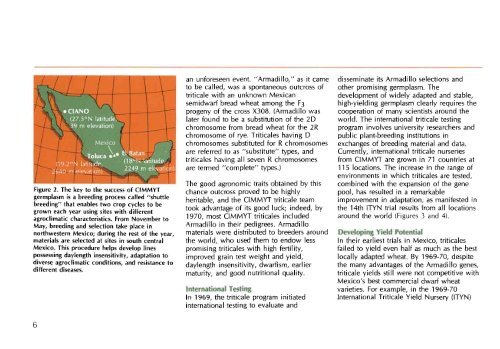U - Search CIMMYT repository
U - Search CIMMYT repository
U - Search CIMMYT repository
You also want an ePaper? Increase the reach of your titles
YUMPU automatically turns print PDFs into web optimized ePapers that Google loves.
Figure 2. The key to the success of <strong>CIMMYT</strong><br />
germplasm is a breeding process called "shuttle<br />
breeding" that enables two crop cycles to be<br />
grown each year using sites with different<br />
agroclimatic characteristics. From November to<br />
May, breeding and selection take place in<br />
northwestern Mexico; during the rest of the year,<br />
materials are selected at sites in south central<br />
Mexico. This procedure helps develop lines<br />
possessing daylength insensitivity, adaptation to<br />
diverse agroclimatic conditions, and resistance to<br />
different diseases.<br />
an unforeseen event. "Armadillo," as it came<br />
to be called, was a spontaneous outcross of<br />
triticale with an unknown Mexican<br />
semidwarf bread wheat among the F3<br />
progeny of the cross X308. (Armadillo was<br />
later found to be a substitution of the 2D<br />
chromosome from bread wheat for the 2R<br />
chromosome of rye. Triticales having D<br />
chromosomes substituted for R chromosomes<br />
are referred to as "substitute" types, and<br />
triticales having all seven R chromosomes<br />
are termed "complete" types.)<br />
The good agronomic traits obtained by this<br />
chance outcross proved to be highly<br />
heritable, and the C1MMYT triticale team<br />
took advantage of its good luck; indeed, by<br />
1970, most C1MMYT triticales included<br />
Armadillo in their pedigrees. Armadillo<br />
materials were distributed to breeders around<br />
the world, who used them to endow less<br />
promising triticales with high fertility,<br />
improved grain test weight and yield,<br />
daylength insensitivity, dwarfism, earlier<br />
maturity, and good nutritional quality.<br />
International Testing<br />
In 1969, the triticale program initiated<br />
international testing to evaluate and<br />
disseminate its Armadillo selections and<br />
other promising germplasm. The<br />
development of widely adapted and stable,<br />
high-yielding germplasm clearly requires the<br />
cooperation of many scientists around the<br />
world. The international triticale testing<br />
program involves university researchers and<br />
public plant-breeding institutions in<br />
exchanges of breeding material and data.<br />
Currently, international triticale nurseries<br />
from C1MMYT are grown in 71 countries at<br />
115 locations. The increase in the range of<br />
environments in which triticales are tested,<br />
combined with the expansion of the gene<br />
pool, has resulted in a remarkable<br />
improvement in adaptation, as manifested in<br />
the 14th ITYN trial results from all locations<br />
around the world (Figures 3 and 4).<br />
Developing Yield Potential<br />
In their earliest trials in Mexico, triticales<br />
failed to yield even half as much as the best<br />
locally adapted wheat. By 1969-70, despite<br />
the many advantages of the Armadillo genes,<br />
triticale yields still were not competitive with<br />
Mexico's best commercial dwarf wheat<br />
varieties. For example, in the 1969-70<br />
International Triticale Yield Nursery (ITYN)<br />
6

















